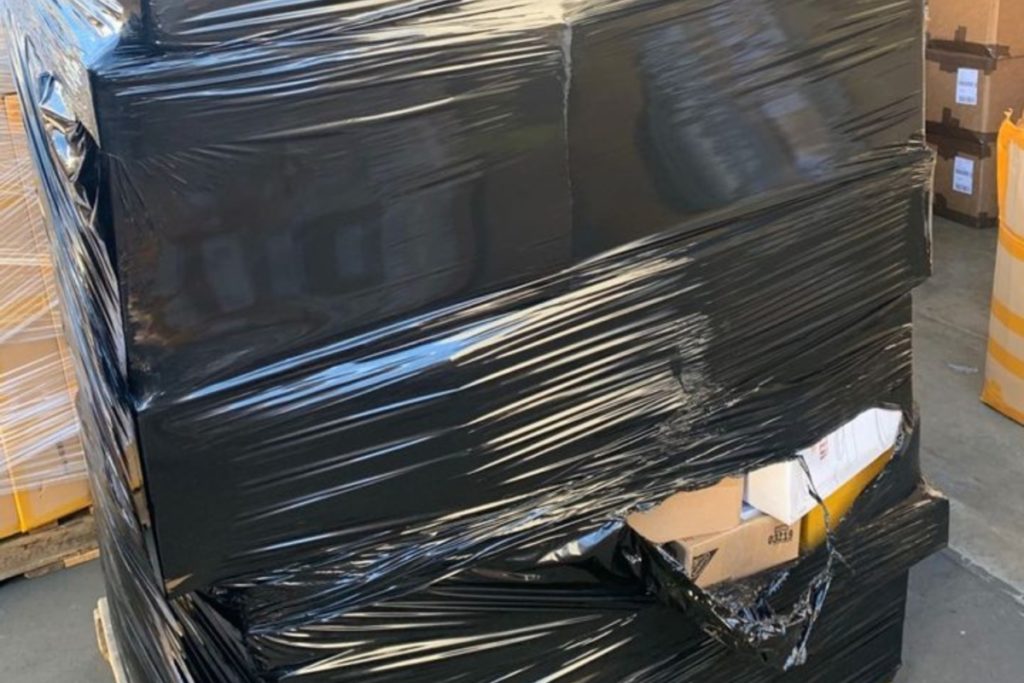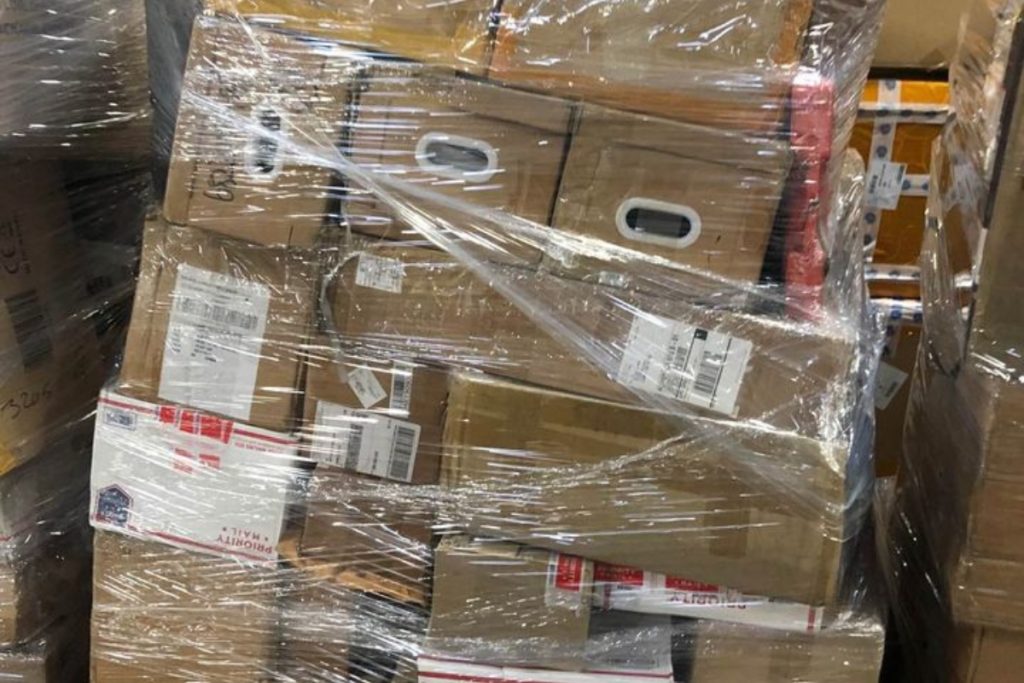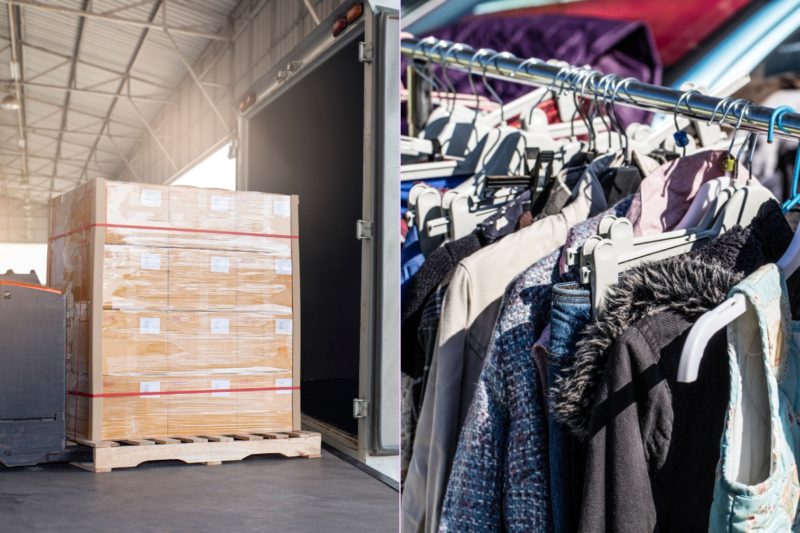If you’re looking to start a new business venture or side hustle, a lot of people want to consider buying and selling Amazon return pallets. Typically, these pallets are purchased at a discounted price and then resold individually or as a lot.
While buying and selling Amazon return pallets can be a profitable venture, it’s important to do your due diligence and carefully evaluate the potential risks and rewards before investing in this market.
What are Amazon Return Pallets?
Amazon return pallets are full of merchandise that has been returned to Amazon by customers. These pallets are typically bought in bulk and contain a variety of new, used, and damaged items from various product categories.
Many of the items found on Amazon return pallets include electronics, home goods, toys, and clothing. The items on these pallets can vary in physical condition, ranging between lightly used or open box items and completely damaged or defective products that you may struggle to sell.
Lots of third-party companies internationally purchase these pallets from Amazon and then resell the items at a discounted price. This attracts buyers so that the seller makes a profit on the merchandise even though it is discounted, since the buyer got the lot even cheaper on their end.

Can Anyone Buy and Sell Amazon Return Pallets?
In general, anyone can buy and sell Amazon return pallets. Anyone interested in buying Amazon return pallets needs to have the necessary capital and meet the requirements of the seller. Though buying pallets is typically cheaper than buying items individually, they can still cost a pretty penny upfront.
However, some sellers may have specific requirements for buyers of their pallets, such as a resale certificate or a business license. If you don’t have a business, you’ll have to find sellers that are willing to sell their pallets to buyers without special qualifications or licenses.
It’s also important for you to do some research and due diligence before buying or selling Amazon return pallets. The market for pallets can be highly competitive and the quality and condition of the products often varies greatly.
Many buyers find it beneficial to gain experience and knowledge in the industry before making significant investments in Amazon return pallets. This means starting small with some cheaper pallets and working your way up as you gain more confidence in the system.
Rarely, though, are there any specific qualifications or requirements for buying and selling Amazon return pallets. Just make sure that you carefully evaluate the potential risks and rewards before investing in this type of market. You don’t want to lose some serious money while trying to make a profit.
How and Where Do I Buy Amazon Return Pallets?
Though you may not have seen them before, there are a lot of places to find Amazon return pallets. These pallets can be purchased from various locations, including online auction websites, liquidation marketplaces, Facebook marketplace, and directly from Amazon through their liquidation program.
You can typically buy Amazon return pallets either in person or online. Though online is the more popular method, some auctions may take place in person, so you can see the pallets for yourself before putting a bid on one. This may be a good option if you’ve never purchased a pallet before and want to learn more about them.
Apart from Amazon itself, some popular websites for buying Amazon return pallets include B-Stock, Liquidation.com, and Direct Liquidation. However, you should always research any seller you’re considering buying from before making a purchase.
Reputable sellers will have reviews from happy customers and be fairly active on their selling platform. They should also be able to respond to your questions fairly quickly depending on the platform you’re using to purchase pallets.
If possible, review the pallets as well before making a purchase, as the quality and condition of the items can vary greatly. For example, don’t bid on a pallet filled with baby clothes if you want one with electronics. Though this may seem obvious, you sometimes have to look carefully at photos and descriptions to make sure you know exactly what you’re purchasing.

How Much Do Amazon Return Pallets Cost?
Though Amazon return pallets can save you some serious money on individual products, buying in bulk is rarely cheap. You’ll pay the cost of the pallet up front, then make a profit as you sell the individual items.
The cost of Amazon return pallets can vary widely depending on a variety of factors. Some factors that may affect the cost of Amazon return pallets include the type and brand of the products included, the level of damage or wear and tear on the products, the number of items on the pallet, and the demand for the products in the resale market.
For example, a pallet with computer monitors will cost much more than a pallet with running shoes.
Generally, the cost of a single Amazon return pallet can range from a few hundred to several thousand dollars depending on the products on the pallet.
You should always thoroughly evaluate the pallet and the items before making a purchase to ensure that the cost is reasonable and aligned with the potential resale value.
It’s also worth noting that some sellers may offer discounts for bulk purchases or for customers who are repeat buyers. It may be to your benefit to establish a relationship with a reliable seller and work with them over time to negotiate favorable prices.
If you have good relationships with others in the pallet resale business, you may find better deals from word of mouth or recommendations. These likely won’t come to you if you remain a stranger or form poor relationships with those you’re buying from.
What are the Most Common Items Found on Amazon Return Pallets?
The most common items found on Amazon return pallets can vary widely and may include any products that Amazon sells. However, some of the most common categories of items found on Amazon return pallets include:
- Electronics (laptops, tablets, cameras, and audio equipment)
- Home goods (appliances, furniture, kitchen products, and decor items)
- Clothing and accessories (shoes, apparel, and jewelry)
- Toys and games (board games, puzzles, and electronic toys)
- Health and beauty products (cosmetics, skincare, hair care items, and personal care products)
- Sports and outdoor equipment (camping gear, exercise equipment, and bicycles)
- Automotive and tools (power tools, hand tools, and car accessories)
Remember that any pallet you invest in may include new, used, refurbished, or damaged products. You likely won’t make a profit on damaged items (if you can even sell them at all), so try to find pallets that only have functioning products that are in good condition.
You might not get lucky even if the items are new and unused. Why? Some brands sell better than others, despite the quality. It’s always a bit of a gamble, no matter what – you can make money on one pallet and lose money on another.
Another thing to note that many forget is that it takes time to resell things. Some items took me a day to sell on Mercari or Marketplace, while other eventually sold after months.
Amazon return pallets can ultimately contain any product that you can find on Amazon. While some products are more popular than others, anything that can be returned can potentially find its way onto a pallet for resale.
The items in the list above are the types of items most commonly found on Amazon return pallets. Often, electronics are returned because they did not fit the needs of the buyer, or they came damaged. These pallets have the potential to be lucrative but are riskier since it is hard to tell from the surface if the items will work or not.
Items like clothing and home goods are much safer for new buyers. You can usually tell quite easily if the items on these pallets are dirty or damaged, so you can decide if it is a good deal or not. However, these items tend to sell more cheaply than items like electronics, so you may make a lower profit. However, it’s really easy to sell clothes on Mercari or on Etsy with a shop.
Items like games, toys, tools, sports equipment, and health products are usually hit or miss. Some of these items may be easy to spot damage on, while others you cannot.
For example, a bottle of lotion may look perfectly fine, but it could be expired or smell bad. This is where you have to consider the reputation of the seller, as well as the quality of the other items on the pallet to determine if you’re making a good investment or not.

Is it Safe to Buy and Sell Amazon Return Pallets?
Buying and selling Amazon return pallets can be a profitable venture for some, but it also comes with risks. The safety of buying and selling Amazon return pallets depends on various factors, such as the reputation of the seller, the quality and condition of the products on the pallet, and the market demand for the products.
One potential risk of buying Amazon return pallets is that the products may be defective, damaged, or unsellable, which can lead to financial losses for the buyer. It is entirely possible that 50% of your pallet might not be resellable and it doesn’t necessarily mean that the pallet seller was bad – it’s a matter of luck.
Selling Amazon return pallets also requires a certain level of expertise and knowledge to effectively market and sell the products. Buying a pallet is great, but it won’t lead you anywhere if you can’t sell the items from the pallet afterward!
You should come up with a plan to sell your items before investing in a pallet. You may want to consider selling online on sites such as eBay or Facebook Marketplace. Or, you could sell at a local flea market if you prefer to sell in person. Either way, you will have to take time to sort, price, and market your items to potential buyers.
Though it all comes with a risk, many experienced buyers and sellers have found success in the Amazon return pallet market. Those who have come up with successful methods to sell their items and have learned to identify lucrative pallets can make a pretty penny with this side hustle. Don’t forget, while safe it’s a lot of work though!
Is it Financially Worth it to Buy and Sell Amazon Return Pallets?
The financial worth of buying and selling Amazon return pallets can vary depending on various factors, such as the cost of the pallet, the quality and condition of the products on the pallet, and the market demand for the products.
If you can purchase a pallet at a low cost and able to resell the items on the pallet for a profit, then it can be financially worth it. However, it’s important to consider the potential risks and expenses involved in buying and selling Amazon return pallets, such as the cost of shipping, storage, and lack of capital you invested in the pallet while you wait for it all to sell.
It’s also important to keep in mind that the market for Amazon return pallets is highly competitive, and the potential profits may not always be consistent or guaranteed. Additionally, the products on the pallets may be damaged or unsellable, which can result in financial losses for the buyer.
Overall, buying and selling Amazon return pallets can be financially worth it for some, but it’s important to carefully evaluate the potential risks and rewards before investing in this market.
Amazon return pallets can be a lucrative business opportunity for those looking to buy and sell bulk merchandise. The prospect of buying affordable items and selling them for profit appeals to many people, but some forget that it involves a LOT of work.
However, always make sure you do your homework before investing in this market, as the quality and condition of the products can vary greatly. You should carefully consider the risks before making any large purchases.
By researching the market, working with reputable sellers and buyers, and gaining expertise in the industry, buying and selling pallets can be financially worth it for some.






Leave a reply